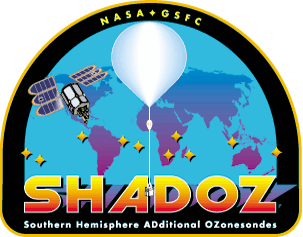Principal Investigator: Dr. Ryan M. Stauffer (NASA/Goddard Space Flight Center)
Founding Principal Investigator: Dr. Anne M. Thompson (NASA/Goddard Space Flight Center)

A number of ozonesonde stations are operating in the tropics, subtropics, and the southern hemisphere in general, but with differing frequency and reporting procedures. SHADOZ (Southern Hemisphere ADditional OZonesondes) is designed to remedy this data discrepancy, by coordinating launches, supplying additional sondes in some cases, and by providing a central archive location. Since 1998, ozonesonde data have been collected and made available through this website.
Questions regarding sonde data from specific stations should be directed to the stations' principal investigator. A list of PI contact information can be found on the PI CONTACTS link in the banner above.
Exciting News for SHADOZ!!!
Starting in 2021, two SHADOZ stations are reactivating and one additional station is joining the network.
For the first time in 8 years, ozonesonde launches in Watukosek, Java, Indonesia have resumed as part of the SHADOZ Network. For more on this, see the NASA Feature Story here and our Newsletter #30. New Watukosek data available on the Archive!
After a 5-year hiatus, the San Cristóbal, Galapagos, Ecuador station will be resuming ozonesonde launches this year and the Quito, Ecuador station is joining the SHADOZ Network (more on this in Newsletter #31). New ozonesonde data from both stations is on the SHADOZ Archive!
Attention!! Ozonesonde Data Caveat!
- A number of global ozonesonde stations report a sharp "drop-off" in stratospheric & total column ozone (TCO) after ~2014.
- 7 SHADOZ stations exhibit a 2-6% "drop-off" in total ozone beginning
2014-2016, depending on the station. See Stauffer et al. (2020) for early findings on the drop-off and Stauffer et al. (2022) for the latest results on the drop-off and the global ozonesonde network stability.
- Update 29 Nov. 2022: Drop-offs in TCO are not getting any worse at the "affected" stations in recent datasets. The drop-off appears to be a combination of an instrument artifact and station operating procedures, which the community is investigating. Click for more information.
- STATUS SUMMARY: V6 SHADOZ data, much improved over v5.2 data [Thompson et al., 2017; Witte et al., 2017; 2018], are recommended for model comparisons, climatology, satellite comparisons. For the affected stations, data above 50 hPa are not recommended for calculation of trends after the onset of "TCO drop.”
We would like to keep a running list of
papers that use SHADOZ data. Please email a reference of your
manuscript to the archiver: Debra.E.Kollonige@nasa.gov
Publications using SHADOZ data should include the following references:
- Witte, J.C., A. M. Thompson, H. G. J. Smit, M. Fujiwara, F. Posny, Gert J. R. Coetzee, ... F. R. da Silva (2017), First reprocessing of Southern Hemisphere ADditional OZonesondes (SHADOZ) profile records (1998-2015): 1. Methodology and evaluation, J. Geophys. Res. Atmos., 122, 6611-6636. https://doi.org/10.1002/2016JD026403.
- Thompson, A. M., J. C. Witte, C., Sterling, A., Jordan, B. J., Johnson, S. J. Oltmans, ... Thiongo, K. (2017). First reprocessing of Southern Hemisphere Additional Ozonesondes (SHADOZ) ozone profiles (1998-2016): 2. Comparisons with satellites and ground-based instruments. Journal of Geophysical Research: Atmospheres, 122, 13,000-13,025. https://doi.org/10.1002/2017JD027406..
- Witte, J. C., Thompson, A. M., Smit, H. G. J., Vömel, H., Posny, F., & Stübi, R. (2018). First reprocessing of Southern Hemisphere ADditional OZonesondes profile records: 3. Uncertainty in ozone profile and total column. Journal of Geophysical Research: Atmospheres, 123, 3243-3268. https://doi.org/10.1002/2017JD027791..
- Sterling, C. W., B. J. Johnson, S. J., Oltmans, H. G. J. Smit, A., Jordan, P. D., Cullis, E. G., Hall, A. M., Thompson, and J. C. Witte (2017). Homogenizing and Estimating the Uncertainty in NOAA's Long Term Vertical Ozone Profile Records Measured with the Electrochemical Concentration Cell Ozonesonde, Atmos. Meas. Tech. https://doi.org/10.5194/amt-2017-397.
Data Disclaimer and Guidelines:
- The data on this website are subject to revision and reprocessing. Check dates of
creation to download the most current version. Contact the co-investigators for
questions concerning data techniques and quality.
Access to these data is free to the public. Whenever substantial use is made of their data, you accept that an offer of co-authorship will be made through personal contact. In all cases, an acknowledgement must be made to the data co-investigators and SHADOZ when these data are used in publication. Click here for a list of contact information on the SHADOZ station PI's
SHADOZ reserves the right to limit access to the Data Archive and to alter or change the layout and content of the website.

